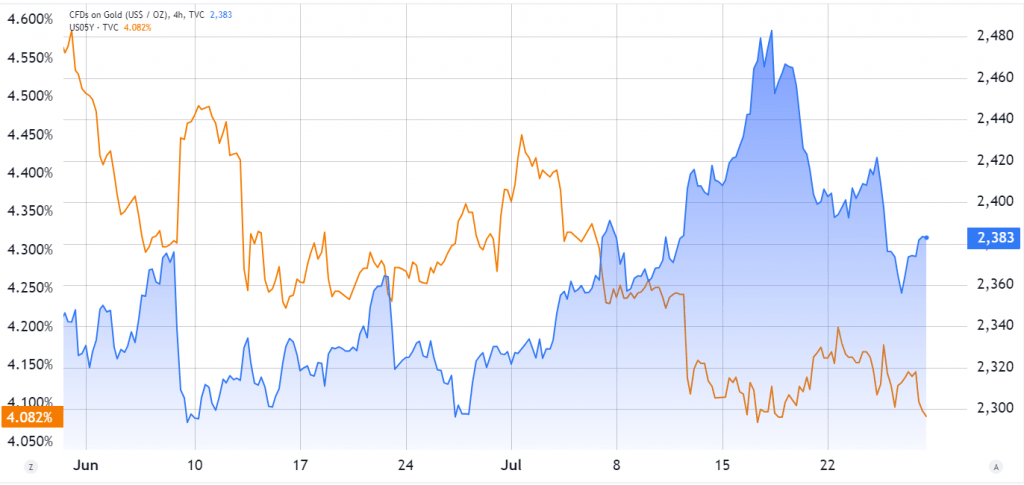
Bitcoin’s Metamorphosis From a Risk Asset to Digital Gold Indicates New All-time Highs
A new set of bullish catalysts is driving up the price of bitcoin.
On July 26, Bitcoin BTC $67,788 experienced a 6% rally and approached the $68,000 barrier level. Interestingly, this change corresponded with significant buying pressure on US Treasury bonds, with the 5-year yield falling to its lowest level since March 2024. Similarly, gold, considered the world’s largest reserve asset, surged 1.4% on July 26 to nearly $2,400.
 US 5-year yield (left) vs. gold (right). Source: TradingView
US 5-year yield (left) vs. gold (right). Source: TradingView
Bitcoin’s growth may appear contradictory considering the growing investor desire for fixed-income securities and gold, but the solution is found in the performance of technology stocks and the real estate market.
A slowing stock market boom and dismal real estate statistics feed Bitcoin’s price
Part of the increasing demand for US Treasury bonds can be ascribed to the US personal consumption expenditure (PCE) price index, which jumped 2.5% in May compared to the previous year, meeting experts’ forecasts. According to the data from Business Standards, which was announced on July 26, personal income climbed by 0.2% over the previous month, which was somewhat lower than the 0.4% market forecast. In short, the evidence supported interest rate reduction by the US Federal Reserve.
A shift to less restrictive monetary policy is usually bad for fixed-income markets and gold, but on July 26, the reverse happened. Investors are concerned that the stock market is about to correct, making alternative assets like Bitcoin more appealing. Furthermore, concerns about weak real estate market statistics are growing, as high borrowing costs dissuade sellers from advertising their properties.
On July 26, Morgan Stanley’s Chief Investment Officer, Mike Wilson, told Yahoo Finance that “cracks” in the bull thesis spurred by “artificial intelligence optimism” and “economic growth deteriorating” will spark a 10% correction for the S&P 500 in the third quarter. Wilson also stated that the government is splurging on fiscal policy “to keep things moving along,” which creates an unfriendly environment for stocks.
According to Keith Lerner, Co-Chief Investment Officer at Truist, the tech sector has outperformed the S&P 500 on a rolling two-month basis by the most since 2002, which has contributed to the recent market decline.
In the real estate market, the number of unsold new homes in the US South reached its greatest level in more than 18 years, led by Florida and Texas. In June, there were 293,000 newly built houses for sale in the southern United States, beating the previous record of 291,000 established in August 2006. PulteGroup CEO Ryan Marshall told Yahoo Finance, “These markets are now in the process of finding the new clearing price needed to work off any excess inventory.”
Investors begin to prefer Bitcoin’s ‘digital gold’ theory.
The recent buying activity by pension funds may be a crucial element in Bitcoin gaining momentum despite the fact that some in the market foresee a correction in the stock market.
In May, the State of Wisconsin Investment Board disclosed a $164 million investment in spot Bitcoin exchange-traded funds (ETFs). On July 25, Jersey City’s Mayor, Steven Fulop, stated that the city’s pension fund would invest in spot Bitcoin ETFs. Furthermore, on July 26, a US Securities and Exchange Commission filing indicated that the State of Michigan Retirement System had invested $6.6 million in a spot Bitcoin ETF.
In essence, Bitcoin’s perception is gradually shifting from a risk-on asset that would typically decline during an economic slowdown that harmed real estate and stock markets to something more akin to gold—an alternative hedge against ever-increasing monetary issuance and unsustainable fiscal government debt.
While there is no assurance that Bitcoin will break beyond its current all-time high of $73,757 in 2024, the probabilities are improving.


